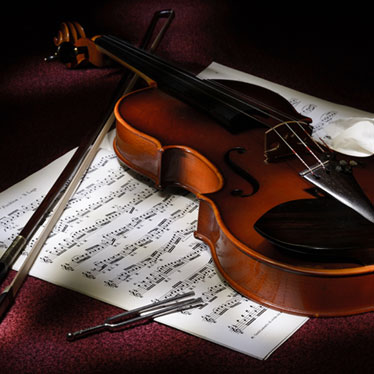3 Steps to Tuning Your Violin

In the beginning, your violin teacher will help you tune your instrument - and is happy to do so because tuning is crucial to developing a good ear and the muscle memory required to play the notes accurately. At some point, though, violin students need to learn to tune their instrument on their own.
Not only is tuning a good skill set to learn as soon as possible, the "audience" (aka - the people who live in and around your practice space) will appreciate it. While technique is certainly important, a violin that slips out of tune will sound as grating as one that's played incorrectly. A quality instrument, good technique and proper tuning are essential for developing the rich, true tones you desire.
A special note about tuning: Always remember to check tuning before you sit down to practice or perform. Also, it's a good idea to check and re-tune your instrument about every 30-minutes or so (maybe more if things sound "off") while practicing, especially if you've just changed the strings, bridge or tuning pegs as it can take a bit of time for parts to set in position.
Step One - Invest in a digital, chromatic tuner
As you advance as a violinist, you'll be able to trust your ears more and more, and will tune using a more advanced method called, "relative tuning." That requires a more experienced ear. Until then, it's a good idea to invest in a digital, chromatic tuner to ensure each string is precisely tuned to the correct interval (violin strings are tuned at 5th intervals).
Step Two - Take your time, one string at a time
Tuning takes place once string at a time, working from the A string first, and then continuing to D, G and finally to E. You'll bow the string continually, listening with your best ears, until the desired pitch is achieved (yes, even though you're using a digital chromatic tuner, you should still listen carefully so your ears learn to recognize the desired pitches).
Eventually, you'll become so adept at this, you'll be able to use relative tuning - a process that relies on your ear's ability to hear 5th intervals. Once someone plays an A on the piano, or a pitch fork, or a correctly-tuned instrument, you'll be able to tune your A string to match, and continue tuning the remaining strings from there.
Step Three - Turn the tuning peg (and fine tuners) in very small increments
In the beginning, and when your instrument is tuned by your instructor, you will probably only require tuning via the fine tuners. Big things happen with very small changes in string tension, so only move the tuners a smidgen at a time if needed, and see what happens. This will feel very awkward at first, and that's okay - every violinist has been there. It's better to learn to tune properly, achieving accurate pitches; ease and speed will come later.
If the violin is so out of tune that you do need to adjust the tuning pegs, move the pegs in very small increments. If you move dramatically in the wrong direction you can alter or damage other parts of your instrument. At best, the bridge may shift out of place and/or you'll snap a string. At worst, you can snap the bridge altogether or break a tuning peg.
How do I know if I should move the tuning peg or the fine tuner?
If your string is only off by a half tone or so, use the fine tuners on the tailpiece to make precise changes. If it's off by more than that, gently maneuver the pegs. When in doubt, always get assistance from a teacher or a more experienced player so you don't cause any undue harm to the instrument.
Things to Remember About Keeping a Violin in Tune
Important things to remember about keeping your violin in tune:
- Do you have new strings? New strings stretch themselves into a more settled position, and this can take a few days. If you've just changed your strings, you'll need to tune more often so have your tuner at the ready.
- Think "push," rather than "turn." Because slight variations in tension create significant changes in pitch, you want to push the peg gently in the desired direction, rather than thinking of "turning" it. If you turn too hard, the peg can move suddenly and this can cause problems.
- Tune regularly. You always want your instrument to be in tune so re-tune any time the instrument has been at rest in its case, even if you tuned and played it earlier that day. Throughout this beginning phase, and until your ear is honed, tune regularly throughout your practice sessions.
Learning to properly tune your violin is the next step in your musical journey.


